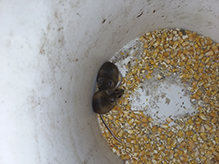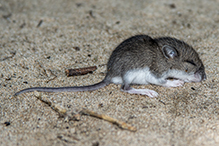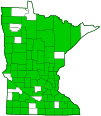white-footed mouse
(Peromyscus leucopus)
Conservation • Description • Habitat • Biology • Distribution • Taxonomy
Conservation Status |
|
|||||||
| IUCN Red List | LC - Least Concern |
|||||||
| NatureServe | N5 - Secure SNR - Unranked |
|||||||
| Minnesota | not listed |
|||||||
Description |
||
White-footed mouse is a medium-sized, nocturnal, ground dwelling mouse. It occurs in the United States east of the Rocky Mountains, in adjacent Canadian provinces, in Mexico, and in Central America. It is very common in most of Minnesota but completely absent in the extreme northeast and most of the Arrowhead region. It is very similar to and difficult to distinguish from the deer mouse, which occurs throughout the state and often in the same habitats. Its preferred habitat is deciduous woodlands and shrubby areas, but it is also found in open areas, disturbed areas, and around buildings. Adults are 3½″ to 4⅛″ (91 to 107 mm) in length from nose to tail, 59 ⁄16″ to 83 ⁄16″ (145 to 205 mm) in total length including the tail. They weigh from ½ to 1⅞ ounces (15 to 25 grams). The coat (pelage) is pale to rich reddish- or orangish-brown with a broad blackish stripe down the back (middorsal). The belly and feet are white. The tail is “gradually bi-colored,” dark above and white below with a narrow region where one color grades into the other. The hairs on the throat are completely white, not gray in the basal half. Juveniles are gray. The eyes are large. The ears are prominent, thin, and sparsely covered with fur. The upper lip is dusky. The tail is long but not quite as long as the head and body, about 45% of the mouse’s total length. |
||
Size |
||
Total length: 59 ⁄16″ to 83 ⁄16″ (145 to 205 mm) Head and body: 3½″ to 4⅛″ (91 to 107 mm) Tail: 2⅜″ to 4″ (61 to 102 mm) |
||
Sign |
||
The hind track of a deer mouse is ¼″ to ½″ long, ⅜″ to ½″ wide, and shows five toes. The fore track is similar in size but shows only four toes. The trail is 1⅜″ to 1¾″ wide, similar to that of a chipmunk only smaller. |
||
Similar Species |
||
Habitat |
||
Mostly deciduous woodlands with shrubby under-story and brushy fields, but also open areas, disturbed areas, and around buildings. |
||
Biology |
||
Behavior |
||
Adults are active year round at night. They spend most of their time on the ground. |
||
Lifespan |
||
1 to 2 years |
||
Life Cycle |
||
|
||
Food |
||
Seeds, nuts, and insects |
||
Distribution |
||||
|
Sources |
|||
| 11/16/2022 | ||||
Occurrence |
||||
Widespread and common |
||||
Taxonomy |
|||
| Class | Mammalia (mammals) | ||
| Subclass | Theria | ||
| Infraclass | Placentalia (placental mammals) | ||
| Magnorder | Boreoeutheria | ||
| Superorder | Euarchontoglires (primates, rodents, and allies) | ||
| Order | Rodentiia (rodents) | ||
| Suborder | Supramyomorpha | ||
| Infraorder | Myomorphi | ||
| Superfamily | Muroidea (muroids) | ||
Family |
Cricetidae (hamsters, voles, lemmings, and allies) | ||
Subfamily |
Neotominae (North American mice and rats) | ||
| Tribe | Peromyscini | ||
Genus |
Peromyscus (North American deer mice) | ||
Subordinate Taxa |
|||
Buxton Woods white-footed mouse (Peromyscus leucopus buxtoni) Cozumel deer mouse (Peromyscus leucopus cozumelae) Martha's Vineyard white-footed mouse (Peromyscus leucopus fusus) Monomoy mouse (Peromyscus leucopus ammodytes) Pungo white-footed mouse (Peromyscus leucopus easti) white-footed mouse (Peromyscus leucopus affinis) white-footed mouse (Peromyscus leucopus arizonae) white-footed mouse (Peromyscus leucopus castaneus) white-footed mouse (Peromyscus leucopus leucopus) white-footed mouse (Peromyscus leucopus incensus) white-footed mouse (Peromyscus leucopus lachiguiriensis) white-footed mouse (Peromyscus leucopus mesomelas) white-footed mouse (Peromyscus leucopus texanus) white-footed mouse (Peromyscus leucopus tornillo) woodland white-footed mouse (Peromyscus leucopus noveboracensis) |
|||
Synonyms |
|||
|
|||
Common Names |
|||
white-footed deermouse white-footed mouse wood mouse |
|||
Glossary
Pelage
The coat of a mammal, consisting of fur, wool, or hair, and including a soft undercoat and stiff guard hairs.
Visitor Photos |
|||||
Share your photo of this mammal. |
|||||
| This button not working for you? Simply email us at info@MinnesotaSeasons.com. Attach one or more photos and, if you like, a caption. |
|||||
Bill Reynolds |
|||||
 |
 |
||||
MinnesotaSeasons.com Photos |
|||||
 |
|||||

Slideshows |
||

Visitor Videos |
|||
Share your video of this mammal. |
|||
| This button not working for you? Simply email us at info@MinnesotaSeasons.com. Attach a video, a YouTube link, or a cloud storage link. |
|||
Other Videos |
|||
| Souris à pattes blanches - Peromyscus leucopus SicnarfGhost |
|||
About
Jan 28, 2017 Souris à pattes blanches - Peromyscus leucopus |
|||

Created: 12/6/2019
Last Updated:


